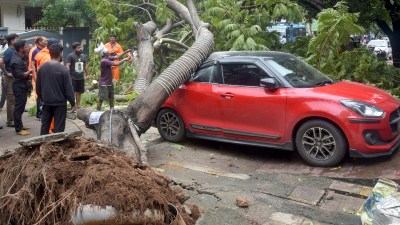Neeti Nigam leads the education department at indianexpress.com. She joined the Indian Express in 2015 and has set up the education and job sections in the online department. She covers schools and higher education, entrance and board exams, study abroad, civil services and other career-related news. Prior to that, she worked as a lifestyle and entertainment journalist in The Pioneer newspaper's magazine division. Besides working in the in-flight Air India (Namaskaar) magazine, she was part of the launch team of Indian Railways on-board magazine Rail Bandhu. She has also worked as a city reporter covering north Delhi in Hindustan Times. In 2012, she covered the MCD elections. You can write to her at neeti.nigam@indianexpress.com ... Read More
NEET UG: Why these lesser-known countries are pulling Indian medical students
Experts point out that there are several reasons Indian students opt to study abroad, even parents want their children to pursue their dreams.
 Students also look for admission in other countries where the competition is less and the tuition fee is nominal. Express Photo by Gurmeet Singh/ representational image
Students also look for admission in other countries where the competition is less and the tuition fee is nominal. Express Photo by Gurmeet Singh/ representational image The Supreme Court Monday directed the government to find out ways to accommodate medical students who have been forced to return home from countries like Ukraine and China. Amid the coronavirus pandemic and the Ukraine-Russia war, Indian medical students have faced a number of issues that have made many MBBS aspirants rethink their plans to study abroad.
For over a decade or more, universities in Russia, China, Ukraine, Nepal, and Bangladesh were favoured the most by medical aspirants in India. According to a recent report by investment firm Anand Rathi, China, Ukraine, the Philippines, and Russia account for almost 60 per cent of the medical student outflow from India.
Opting for new countries
India has almost 92,000 MBBS seats for undergraduates, with over 48,000 of these in government colleges and nearly 44,000 in private colleges. Despite the addition of 30,000 seats for MBBS courses in India in the last six years, the number of candidates stands at six students per seat in 2016 to 10 in 2021, according to a recent report by Anand Rathi.
Experts say because of this stiff competition in India, Middle East and Eastern European nations like Tajikistan, Kazakhstan, Kyrgyzstan, Georgia, and Armenia have seen an increase in the number of Indian students opting to study in these countries in the last six to seven years.
 These countries have seen an increase in FMGE screening test registration. (Data source: natboard.edu.in). Graphic by Dinkar Sasi
These countries have seen an increase in FMGE screening test registration. (Data source: natboard.edu.in). Graphic by Dinkar Sasi
Gaurav Tyagi of consulting firm CareerXpert said apart from the Middle East, South American and Eastern European countries are also emerging as options for Indian students. “Because of the global events that have happened in these three years, Eastern Europe, Middle East, and African nations like South Africa and Nigeria will pick up among students,” he said.
Those who have deep pockets prefer Singapore, the US, the UK, Canada and Australia. Not many, experts say, wish to return to India to practice as the fees are over one crore.
Career counsellors said they have also been receiving queries for admission to universities in Russia’s neighbouring countries like Latvia, Belarus, Romania, and Moldova. “Lesser-known countries will benefit. However, now more students will move towards already popular nations like Nepal and Bangladesh. Besides cultural similarities, students there study the same books that Indian medical colleges teach,” said Parijit Mishra, Head of Department, Career Counselling, Allen Institute.
From quality of education to lower cut-offs and fee
Students also look for admission in countries where the competition is less and the tuition fee is nominal. While the NEET UG counselling is underway, study abroad consulting agencies are addressing concerned parents who are scouting for countries that can “provide quality education at affordable fees” to their wards.
“In India, a candidate has to cough out nearly Rs 80 lakh-Rs 1 crore for a medical seat in a private college. Most families cannot afford this but also can’t let go of their MBBS degree dream. Due to this, they are selecting medical colleges in countries that are easy to get admission to irrespective of whether these institutes are famous for their medical education or not,” Tyagi of CareerXpert said.
On the other hand, the MBBS or UG level tuition fee is nearly Rs 25-35 lakh in these countries.
 NEET UG 2022 Counselling is underway. (Express Photo by Sahil Walia/ Representative Image)
NEET UG 2022 Counselling is underway. (Express Photo by Sahil Walia/ Representative Image)
Not just lower fees, these foreign varsities demand NEET qualifying marks or passing marks of Class 12 or equivalent for admission. Their cut-off is as low as 110 and for the leading medical colleges in India, the cut-off for the general category range is 715-717.
Not as popular as Russia or China, European countries like Germany, France, and the Netherlands are a few other countries that are also rapidly gaining popularity among students who wish to study abroad.
According to Vibha Kagzi, Founder-CEO, ReachIvy said this is primarily because the tuition cost is relatively low in Germany and it also provides top-notch education. “There are several global career opportunities to explore once you finish your education in these countries. Moreover, other eastern European nations such as Romania, Poland, and Hungary are also emerging as the new potential educational destination for MBBS students and are filling up the niche left by Russia and Ukraine,” she said.
She added many students also opt for foreign countries as it provides them with the opportunity to explore new cultures and traditions.
Shreya Trishal, a student pursuing an MBBS course at the Poznan University of Medical Sciences, Poland, has her reasons for going to either the US or the UK rather than coming back. “Abroad universities focus a lot on research as well, something that interests me. I have decided to pursue research in this field and developed countries have better resources and future,” Trishal said.
High demand for medical courses
Over the years, the overall registration for medical courses has gone up in comparison to engineering degrees.
Dr Sayad Ahmad, Vice-President, All India Medical Students’ Association (AIMSA), said this might be because the employability of engineers has gone down and students, therefore, prefer a career in medicine. “There was a time when parents were unwilling to get their students admitted to medical colleges due to high fees and the over five-year course duration. This mindset has changed and there is a bright future for even those who have not pursued post-graduation,” Ahmad said.
If surveys are to be believed, not all engineers are employable. Many have to complete either MBA or MTech to be industry ready. However, an MBBS is still employable. “The salary of the district hospitals doctors or those practising at the mohalla clinics is around Rs 80,000. Therefore, the parents now take medical education as a one-time investment that can give long-term profit,” said Ahmad.
These are among the reasons which probably lead to a boost in the number of students taking up medical entrance exams. In 2013, when NEET was first conducted, about 7.5 lakh students registered for the exam while nearly 11 lakh registered for JEE Main. The applications for NEET has seen a massive spike with nearly 18 lakh application in 2022.
Several NEET toppers also told indianexpress.com the pandemic has further inspired them to take up the medical profession.
Despite the demand for medical education, Ahmad of AIMSA, however, said parents must also take into account the many challenges their children face in foreign countries, especially those like Georgia where India does not even have an embassy.
“I have come across students whose parents are either doctors or are related to them. They might be taking a risk, however, they are sure that their child will at least get a foreign degree that they can show off. They don’t realise in a foreign land one has to learn a new language to survive. The MBBS itself is a tough course. The additional pressure of language and staying away from family further depresses the student,” said Ahmad of AIMSA.
Another word of caution
To ensure a quality check, the Union Ministry of Health and Family Welfare conducts the Foreign Medical Graduates Examination (FMGE)—a compulsory screening test that a foreign degree holder has to take up in order to be eligible for practice in India before their registration with the Medical Council of India (MCI).
Dr Jayshree Mehta, former MCI president, raised concern that the language and curriculum in most foreign universities are not in sync with Indian medical education. “How many students pass FMGE in India? Very low. The problem is that in countries like China, the students have to learn the local language. But the colloquial language is different from what we learn. The international students have to take the help of a translator to be able to communicate with the patients. When these students return to India, we have noticed, their skills are not up-to-the-mark,” said Mehta pointing out that a majority of these medical graduates prefer to practice in India.
According to the National Board of Examination (NBE) that conducts FMGE, the number of medical graduates who took the test increased from 12116 in 2015 to 35774 in 2020. In 2019, 28597 medical students appeared for which 7375 passed with an overall pass percentage of 25.79. In 2020, 35774 applied for FMGE and 5897 cleared the test taking the pass percentage to as low as 16.48. In 2021, 40740 applied for FMGE of which 9996 cleared it taking the pass percentage to 24.54.
“The candidates and especially their families need to understand that the curriculum and the training quality in a majority of these foreign universities are not as good as in India. There are certain skill benchmarks required for practice in India which not everyone can qualify. Therefore, they should think holistically before making any decision,” said Mehta.





- 01
- 02
- 03
- 04
- 05



























